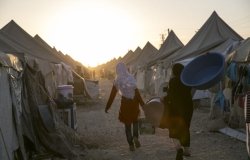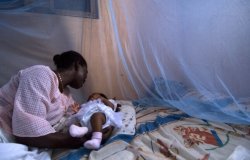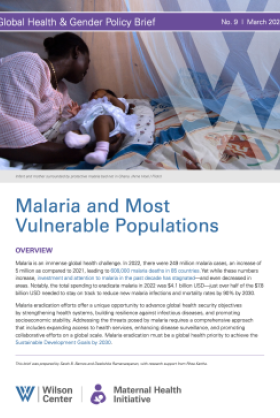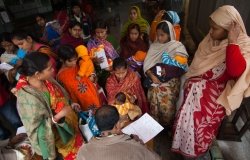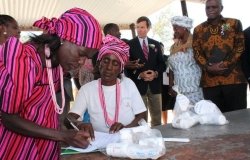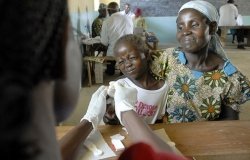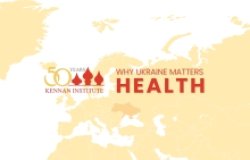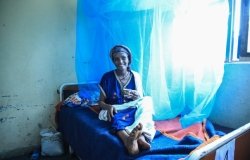Health Crisis: HIV/AIDS in Developing World Cities
The Comparative Urban Studies Project and the Environmental Change and Security Project bring together seven practitioners to discuss the status of community-based initiatives to fight HIV/AIDS in developing world cities.
Overview
On February 23, the Comparative Urban Studies Project, along with the Environmental Change and Security Project, brought together seven practitioners from lenders and NGOs to discuss the status of community-based initiatives to fight HIV/AIDS in developing world cities.
Alexandria Panehal, director of the Urban Programs office of USAID, began the program by explaining that her office was interested in HIV/AIDS since the economic and demographic characteristics of urban areas greatly influence the design and results of HIV/AIDS policies. The Urban Programs office is developing multi-sectoral, mission-focused policy approaches directly with two African countries. The goals of this endeavor include supporting the sharing of best practices by the network of African mayors (AMICAAL), incorporating HIV/AIDS into existing mainstream programs like youth employment outreach, and disaggregating urban and rural data in health surveys. Ms. Panehal suggested that future research should seek to improve health surveys, study migration patterns (both rural-urban and urban-rural) to understand their influence on the spread of the disease, compile and publish municipalities' best practices, and analyze household surveys to understand the coping strategies of urban populations.
Arachu Castro, director of the Institute for Health and Social Justice at Partners in Health, offered an in-depth presentation on HIV/AIDS in Haiti, identifying urban-rural interaction as a major factor in spreading the disease. AIDS is the leading cause of death among adults in Haiti; the country's six percent infection rate is the highest in the Western Hemisphere and is surpassed only by countries in sub-Saharan Africa. Factors influencing HIV/AIDS in Haiti include migration patterns, a declining economy, increased political violence, and an aid embargo. The roots of Haiti's HIV problem can be traced to male prostitutes who had sex with both female girlfriends and male tourists. Dr. Castro cited a 1980s study that rural women who worked in the city or had sex with truck drivers and soldiers were several times more likely to have HIV/AIDS than other rural women; other indicators (such as number of partners) did not correlate. As rural residents migrated to urban areas to find employment, infection rates among hotel workers and servants increased, exacerbated by the problem of rape. Two major issues affecting Haiti's ability to control the disease are the high cost of highly active antiretroviral therapy (HAART) drugs and the lack of infrastructure to administer and distribute them. Through an initiative sponsored by the Global Fund to Fight AIDS, Tuberculosis, and Malaria, Partners in Health offers screenings and treatment for tuberculosis and STDs, and improves HIV prevention and care. Recent research in Haiti shows that the number of those willing to be tested for HIV increases dramatically when treatment options are available. Some of Partners in Health's successful initiatives include paying school fees for the children of HIV-positive patients, upgrading basic housing to inhibit the spread of common diseases, and hiring community health workers—some of whom are HIV positive—to administer drugs and offer social support.
Ron MacInnis, a technical advisor to USAID's NGO partners working in HIV/AIDS, outlined USAID's objectives, which include preventing new HIV/AIDS infections and providing care for the infected. He explained that the agency works mainly with faith-based and community organizations, as well as the private sector, in its efforts to quell the spread of HIV/AIDS. MacInnis discussed how fast the disease spreads in areas of concentrated population, pointing out that Africa is the fastest urbanizing region in the world. He recommended expanding survey data and adjusting strategies to account for regional differences. Although health services are generally more available in urban areas than in rural ones, urban residents still do not fully utilize them due to the high cost, the lack of basic health, education and community mobilization, and cultural prejudices and stigma. MacInnis suggested that these barriers could be overcome by targeted high-quality interventions, capacity building among NGOs and local institutions, and increased educational campaigns in slums.
Nina Schuler, an urban poverty specialist with the Urban Development unit of the World Bank, discussed local government responses to HIV/AIDS. Since it increases demands for public services while reducing household capacity, HIV/AIDS destabilizes the local economy and undermines local government capacity. However, local governments can address the problem by fighting stigmatization and changing workplace policies. By mainstreaming HIV/AIDS into policy and integrating decentralized planning, officials can use existing resources to fight the disease. The World Bank handbook outlines options for local governments in an effort to institutionalize responses to the disease, since turnover among mayors and municipal administrators is often high. The handbook presents five steps: leadership and teambuilding, understanding the local situation, strategy development (including workplace policies, mainstreaming, and functional integration/continuum of care), implementation, and monitoring and evaluation. The World Bank's Multi-Country AIDS Program, administered through grants and loans, focuses on building capacity, integrating civil society, increasing coordination, and improving management, monitoring, and evaluation.
Paulo Lyra, HIV/AIDS communications advisor for the Pan-American Health Organization, spoke about multi-sector, community-based approaches to coping with the disease. From the beginning of the epidemic, communities have raised awareness, provided support, denounced inertia, demanded actions from official sectors, and advocated for allocation of resources. These positive actions sometimes led to negative results, such as discrimination, burnout due to lack of capacity, and false expectations. Lyra stressed that changing political and social norms is key to changing behavior and effectively coping with HIV/AIDS. Media strategies like television interviews with HIV/AIDS patients using false names and obscured faces increase stigma. Instead, credible sources, such as community members suffering from the disease, should be utilized to dispel harmful myths. Lyra reported that Latin America (mainly Brazil) and the Caribbean use half of all antiretroviral treatments outside of the United States. To reach its "3 by 5" goal (three million HIV/AIDS patients on antiretroviral treatment by 2005), the World Health Organization will utilize the community engagement methodology to implement its program.
Sue Simon, associate director of the International Harm Reduction Development program at the Open Society Institute (OSI), described her program's efforts to reduce harm in Eurasia. Currently, the program supports population-based initiatives in 23 countries, focusing on sex workers, prison inmates, Roma, and street kids. Programs include needle exchanges, condom distribution, and health education, as well as study tours. OSI gives matching funds for no more than five years to pilot projects and experimental programs to improve their ability to leverage funds from other sources. The former Soviet Union suffers from the highest rate of new HIV infections in the world, fueled by repressive drug policies, widespread stigmatization of drug users and people living with HIV/AIDS, and a lack of governmental support for effective interventions. However, there have been several positive developments recently: 19 countries have approved drug substitution therapies, funding for harm reduction in the region has increased, more stakeholders are involved, and HIV prevention's link to treatment and support has strengthened. Simon recommended institutionalizing harm reduction programs, ensuring equal access to HIV treatment for drug users, reforming drug policy, expanding substitution therapy, and eliminating repressive and punitive policies.
Lane Porter, international health law and human rights advisor for The Futures Group International and its POLICY Project, reported his group's efforts to reform HIV/AIDS legislation. The POLICY Project collects regional HIV data, identifies national norms and policies, compares them with constitutional and international human rights standards, researches a human rights solution, and proposes and advocates new rights-based policies. In Tanzania, his group identified five priority areas where law reform could facilitate HIV/AIDS prevention: increase voluntary counseling and testing services as a preventive measure, abolish customs and traditional practices that make individuals vulnerable to HIV transmission, protect the rights of persons living with AIDS by preventing stigmatization and employment discrimination, protect the rights of women and children, and institutionalize deterrent measures against willful HIV transmission. While advocating these changes, an association of female Tanzanian lawyers (TAWLA) discovered their ability to influence policy. The Ministry of Justice subsequently urged law schools to teach courses on law and HIV/AIDS to continue the program's positive results. Ultimately, Porter's group effected legal changes that led to better policies, thus improving strategies and practices to fight HIV/AIDS.
The panel's discussions revealed the dimensions of the HIV/AIDS crisis in developing world cities, and presented many strategies to cope with the disease, ranging from policy changes, such as POLICY's efforts to reform legislation, to community-level activities like Partners in Health's program to employ community educators to administer antiretroviral drugs. All of these strategies must be adjusted to reflect regional differences, but they serve as excellent models for fighting the spread of the epidemic in both urban and rural areas.
Speakers
Alexandria Panehal
Arachu Castro
Ron MacInnis
Paulo Lyra
Sue Simon
Lane Porter
Nina Schuler
Hosted By

Urban Sustainability Laboratory
Since 1991, the Urban Sustainability Laboratory has advanced solutions to urban challenges—such as poverty, exclusion, insecurity, and environmental degradation—by promoting evidence-based research to support sustainable, equitable and peaceful cities. Read more

Environmental Change and Security Program
The Environmental Change and Security Program (ECSP) explores the connections between environmental change, health, and population dynamics and their links to conflict, human insecurity, and foreign policy. Read more
Thank you for your interest in this event. Please send any feedback or questions to our Events staff.

